Wondering how to manage LMS Sync campaigns? Check our detailed instructions on how to create and configure a campaign in LMS Sync.
You can view the detailed instruction on how to create a Campaign in LMS SYNC.
To create a Campaign in LMS SYNC, go to the Client Management > Setup > Campaigns section.
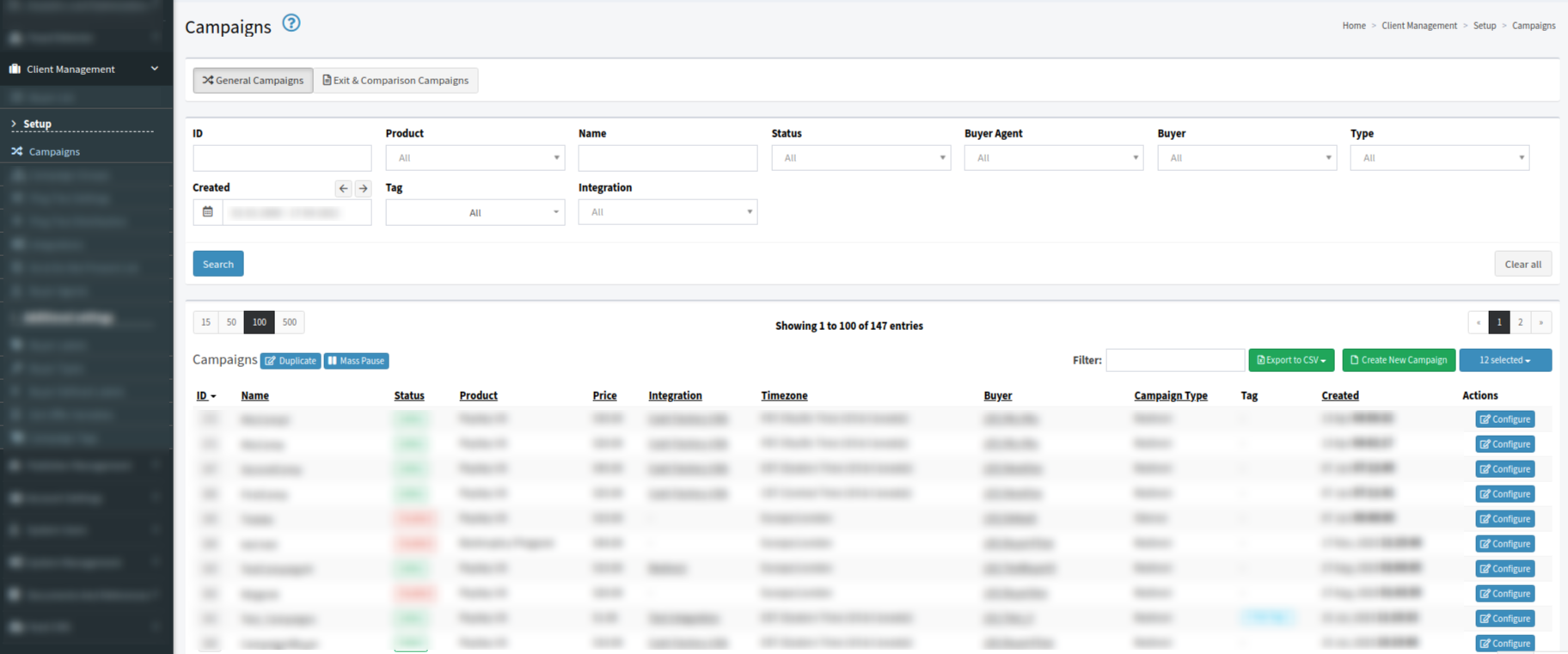
To create a Campaign, click the “Create New Campaign” button and fill in the following fields in the “Create New Campaign” pop-up window:
-
Name: Enter the name of the Campaign.
-
Product: Select which Product the Campaign will be assigned to.
-
Buyer: Select which Buyer the Campaign will be assigned to.
-
Campaign type: Select the Campaign type. Read more about the Campaign types in the article.
-
Timezone: Select the timezone of the Campaign from the drop-down list.
-
Min Price: Enter the minimum price of the Campaign.
Click the “Add” button to save.
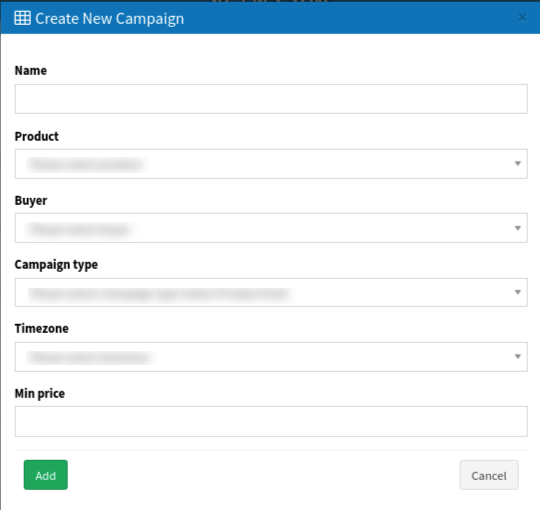
Configure a Campaign
To configure the Campaign, click the “Configure” button in the “Actions” column.
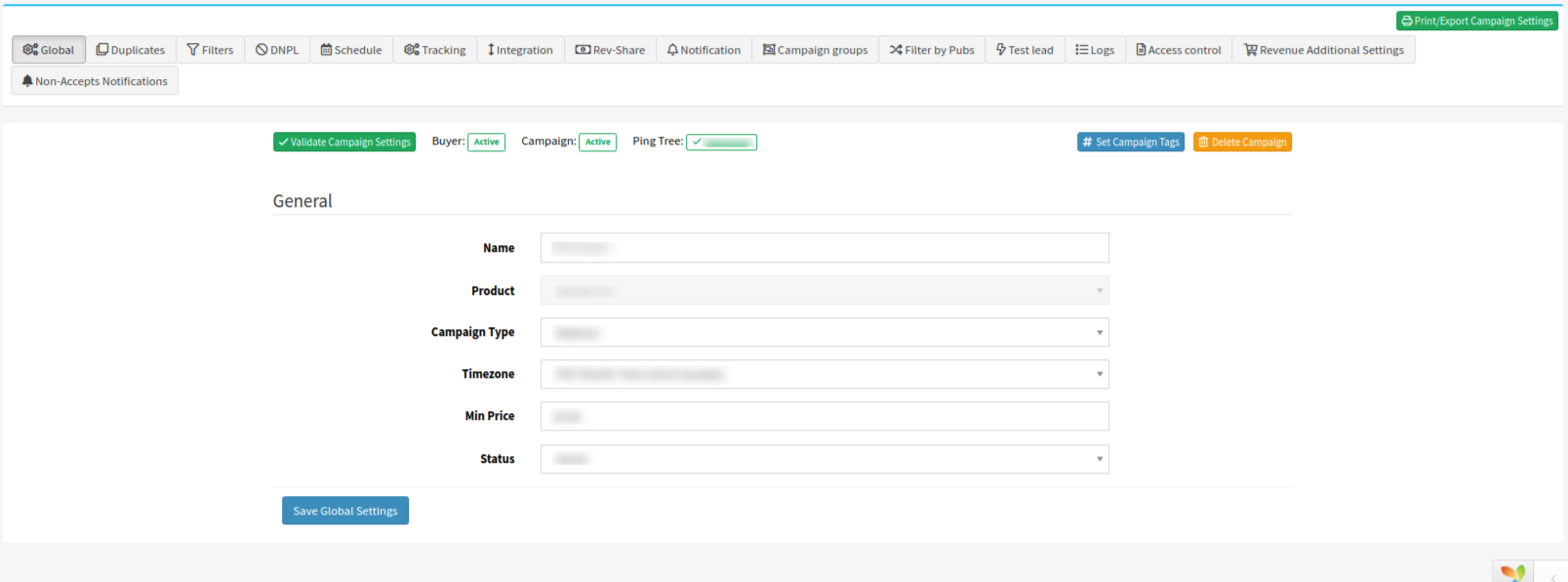
You must configure the Duplicate, Schedule, and Integration tabs of the Campaign, while the remainder tabs are optional. To check if all required fields are set up, click the “Validate Campaign Settings” button to proceed.
Required Tabs
Schedule
The Schedule tab allows you to manage the Campaign schedule and set up limits for post and sold leads.
To configure the schedule settings for a Campaign, go to the Client Management > Setup > Campaigns section, choose the Сampaign and click the “Configure” button in the “Actions” column, and select the “Schedule” tab.
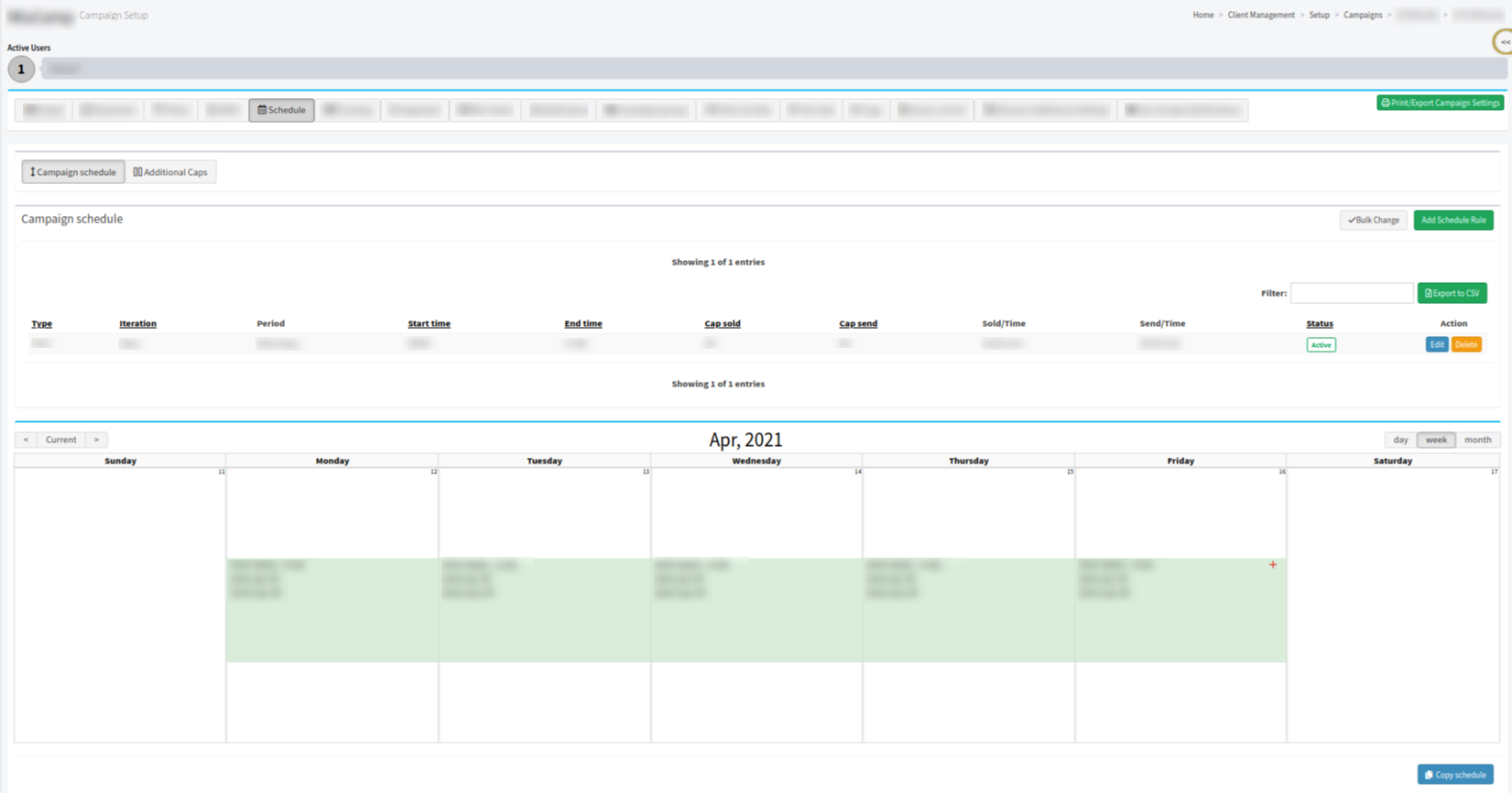
To add a new rule, click the “Add Schedule Rule” button.
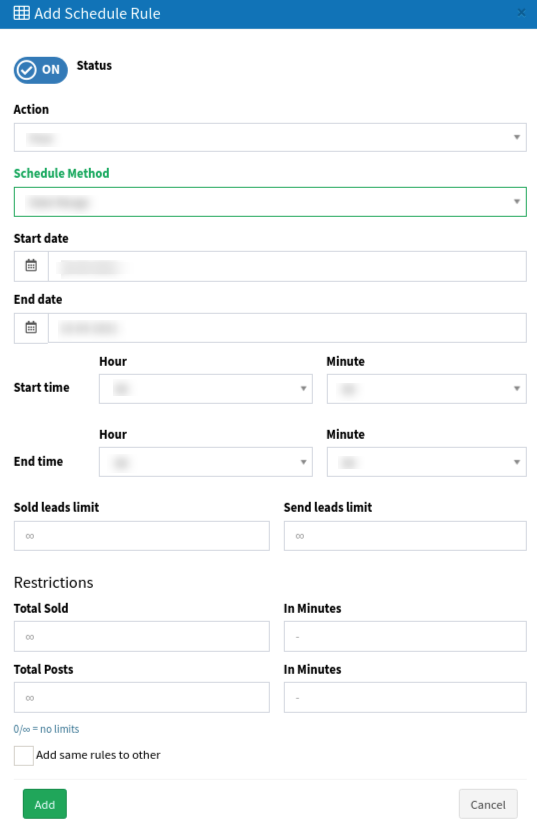
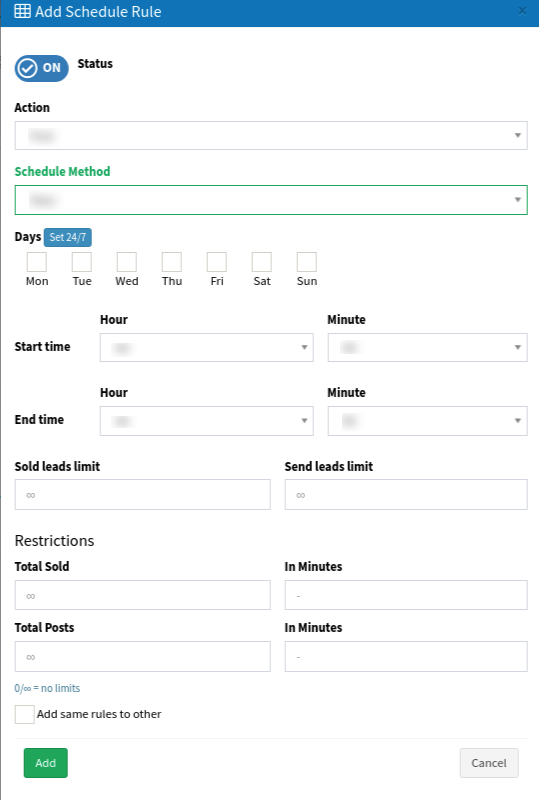
Fill in the following fields in the "Add Schedule Rule" pop-up window:
-
Action: Post / Do Not Post.
-
Schedule Method: Days / Date Range. If the “Days” option is selected, you can select a day of the week using the corresponding checkboxes. If the “Date Range” option is selected, you can select the “Start Date” and “End Date” for the rule in the fields.
-
Start and End time: Select the duration of time for the schedule rule.
-
Sold and Send lead limits: Enter the maximum number of sold and send leads for the schedule rule.
In the “Restrictions” block, you can set up the lead processing limits. You can manage the following values:
-
“Total Sold”: Enter the maximum number of leads that can be purchased by the Campaign within the time frame selected in the “In Minutes” field.
-
“Total Posts”: Enter the maximum number of leads that can be posted to the Campaign within the time frame selected in the “In Minutes” field.
To make changes to the current rule, click the “Edit” button in the “Action” column. To delete a current rule, click the “Delete” button.
To copy the schedule settings to other Campaigns, click the “Copy Schedule” button at the bottom of the page.

Select the schedule settings of which Campaign you would like to copy in the “Select More Campaigns” field (only Campaigns with the “Active” status are available for selection). Enable the “Replace” checkbox to copy the schedule to the selected Campaign(s) without overriding the existing schedule. Enable the “With overwrites” checkbox to copy the schedule to the selected Campaign(s) with override(s).
Note: Copying the above schedule settings will delete the Campaign(s) current schedule and erase all overwrites if you copy the schedule to the Campaign with the existing schedule.
Click the “Apply” button to copy the settings.
You can delete schedule settings in bulk.
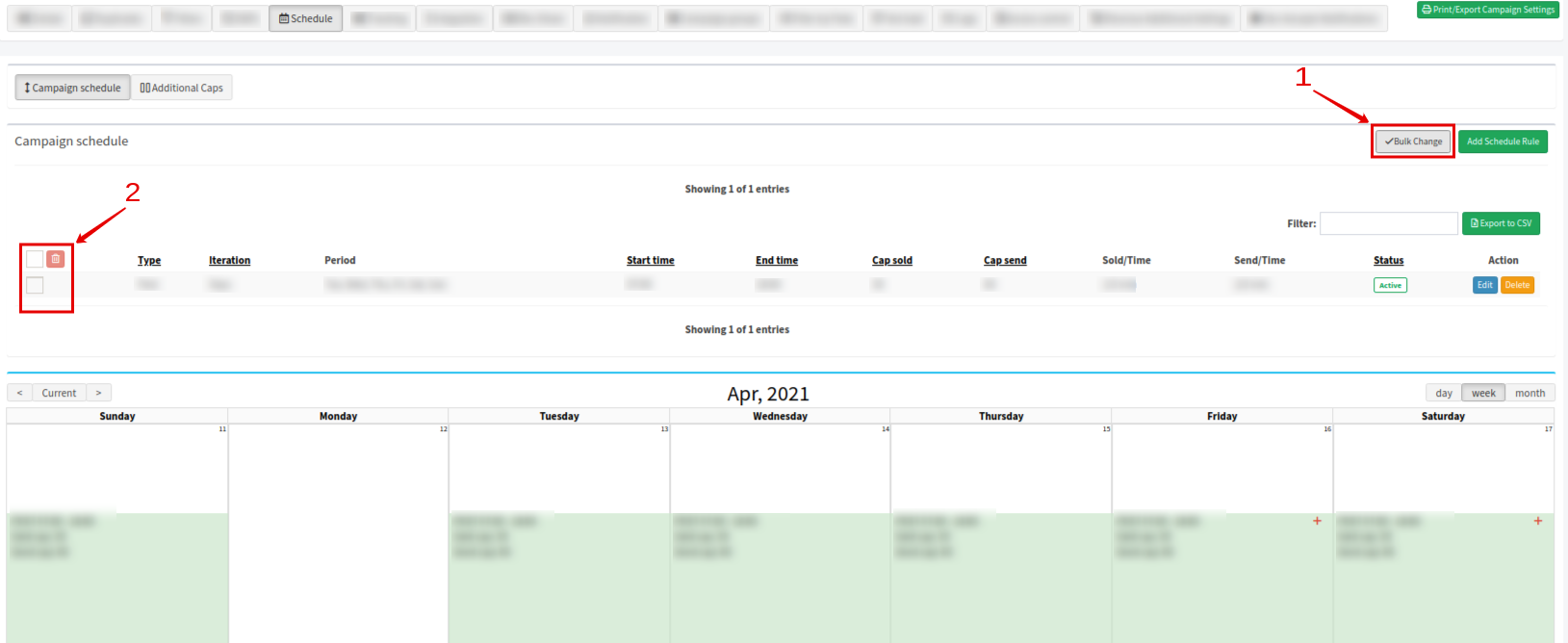
To bulk remove Schedule Rules, click the “Bulk change” button (1) and select the schedule rules (2) you want to delete. Click the red delete icon to delete the selected Schedule Rules.
Integration
The “Integration” tab allows you to manage integration settings for the Campaign.
To configure the integration settings for a Campaign, go to the Client Management > Setup > Campaigns section, choose the Campaign and click the “Configure” button in the “Actions” column, and select the “Integration” tab.
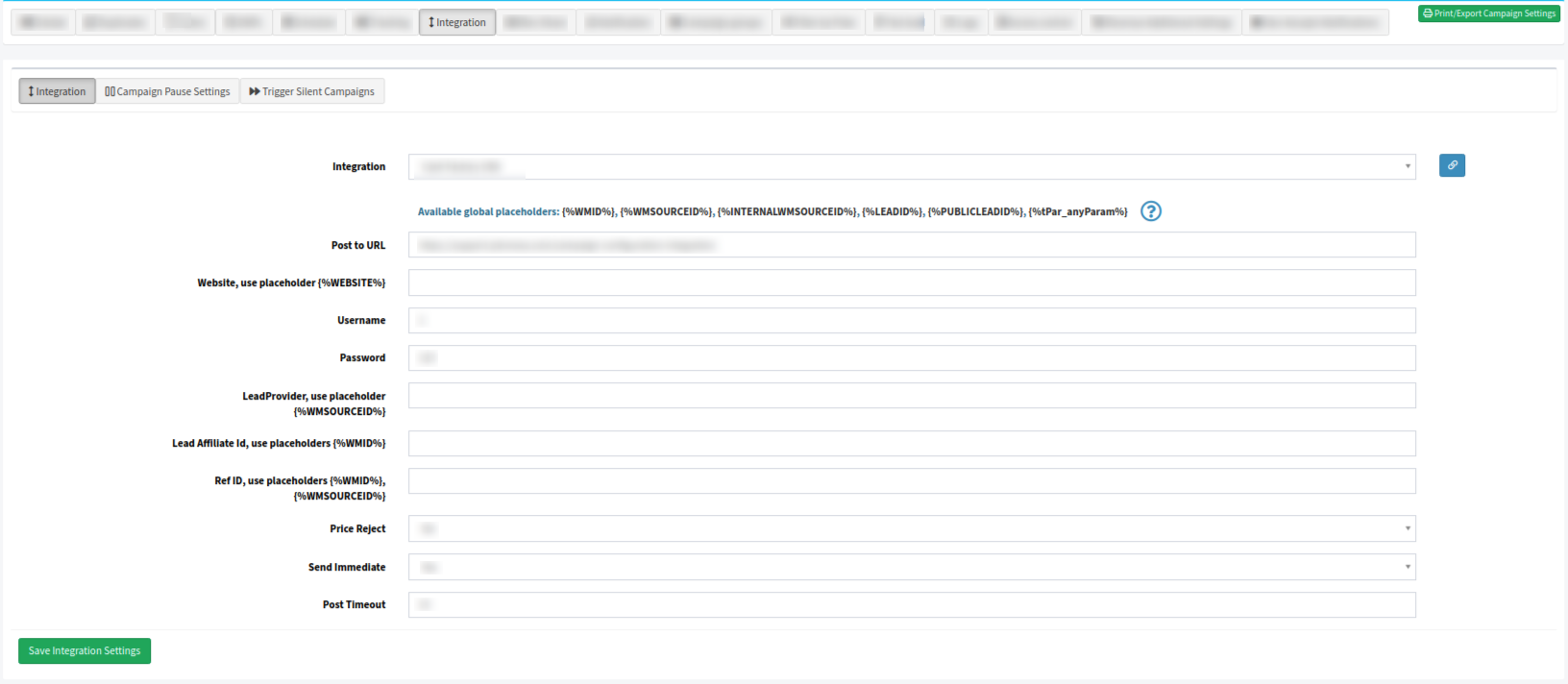
There are three tabs available for the integration setup: “Integration,” “Campaign Pause Settings,” and “Trigger Silent Campaigns”.
The “Integration” tab allows you to configure the integrations settings. Select the Integration field in the “Integration”, and fill in the required fields.
Global Placeholders are available for all integrations and can be used in most of the integration fields except for Post Timeout and some fields specific to an Integration.
{ %WMID% } - internal publisher ID in the system. You can find the Publisher ID in the Publisher List in the ID field column.
{ %WMSOURCEID% } - source name/ID sent by the Publisher. You can find it in the "Name" column of the Publisher Sources section.
{ %INTERNALWMSOURCEID% } - internal Publisher Source ID in the system. You can find it in the "ID" column of the Publisher Sources section.
{ %LEADID% } - internal Lead ID in your system. You can find it in the "ID" column of the Lead Details Report.
The “Campaign Pause Settings” tab allows you to temporarily pause a Campaign based on a buyer’s response through API.

In the “Search response for” field, enter the text from the response that will trigger the system to pause the Campaign.
In the “Pause for'' field, enter the pause duration (in minutes) if the system triggers a Campaign pause based on the buyer's response.
To add another rule, click the “Add Pause settings” button. Click the “Save Pause Settings” button to apply the changes.
The “Trigger Silent Campaigns” tab allows you to set up triggers for silent Campaigns. Read more about this tab in the Knowledge Base.

Optional but highly recommended
Duplicate
A duplicate lead is a lead that has already been seen in the system. Duplicate leads are identified by set criteria such as email, phone number, etc. To set up the duplication rules, go to the Client Management > Setup > Campaigns section, choose the Campaign and click the “Configure” button in the “Actions” column, and select the “Duplicates” tab.
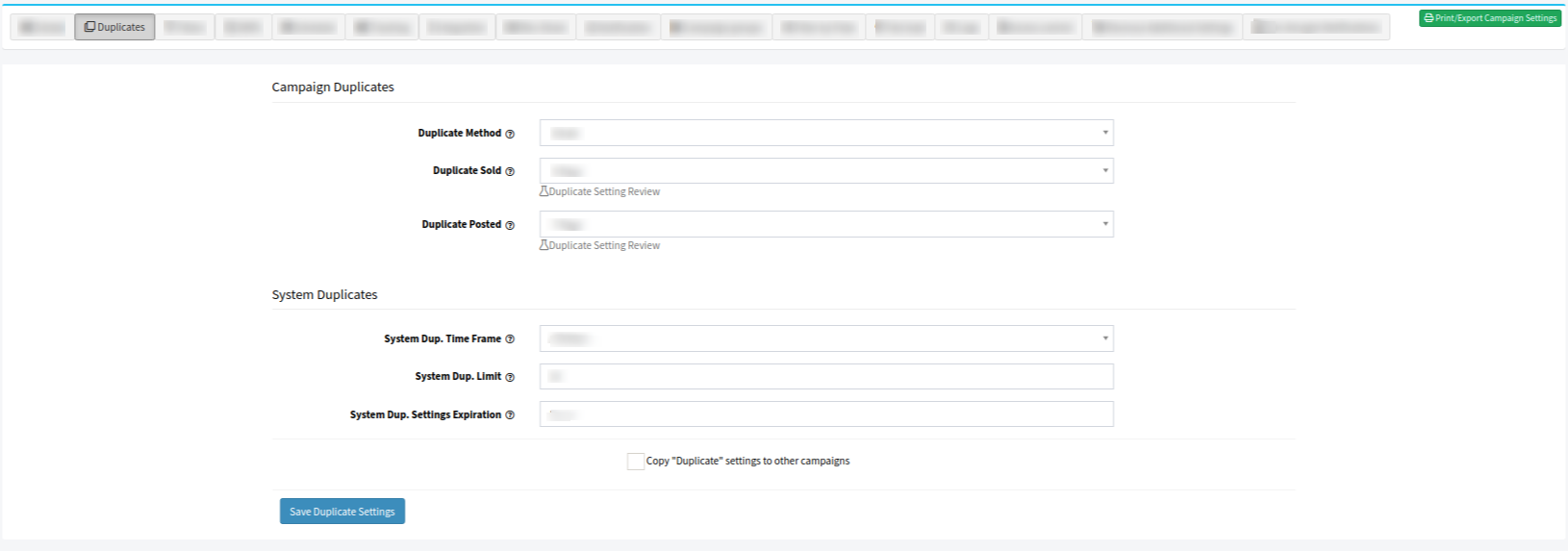
The Campaign Duplicates section allows you to configure the rules that filter out leads on the Campaign level based on the chosen duplicate filtration method and time frame. You can manage the following fields:
-
Duplicate Method: The duplicate method is used to identify which criteria determine a duplicate lead. For example, you can identify a duplicate lead by:
-
Email or Email+SSN for LMS SYNC.
-
Phone or Phone Number+SSN for Call Logic.
-
-
Duplicate Sold: This rule will not post a duplicate lead purchased by this Campaign within the selected time frame.
-
Duplicate Posted: This rule will not post a duplicate lead to this Campaign within the selected time frame.
The System Duplicates section allows you to set the system level duplication rule that defines the maximum number of times that a lead can be seen in the system within a selected time frame before it gets filtered out from the specific Campaign. Additionally, you can set a system-level duplication rule expiration date. You can manage the following fields:
-
System Dup. Time frame: The time frame for checking lead duplication in the system. When OFF is selected, the system level duplication rule is disabled.
-
System Dup. Limit: The maximum number of times the lead can be seen in the system within the selected time frame before it gets filtered out from a Campaign. The default value is set to 1. If the value is set to 0, this duplication rule is disabled.
-
System Dup. Settings Expiration: Optionally, you can set the expiration date for the system level duplication rule.
Click the “Save Duplicate Settings” button to complete the duplicate configuration.
Additional tabs
-
The General tab allows you to view general information about the Campaign and manage global campaign settings. Read more about this tab in the Knowledge Base.
-
The Filters tab allows you to configure and manage additional filtering options for the Campaign. Read more about this tab in the Knowledge Base.
- The “Filter iClear” subtab allows you to configure the campaign filters for third-party services enabled for the product. Read more about this tab in the Knowledge Base.
-
- The DNPL subtab allows you to set up a Present or Do Not Present Lists for the Campaign. Read more about this tab in the Knowledge Base.
- The Filter by Publishers subtab allows you to set up caps for Publishers, add Publishers to White and Black Lists, temporarily block Publishers and manage the traffic percentage settings. Read more about this tab in the Knowledge Base.
-
The Tracking tab allows you to set URL tracking to send lead parameters to your third-party tracking system. Read more about this tab in the Knowledge Base.
-
The Revenue tab allows you to set up a custom payout scheme for a Publisher. Read more about this tab in the Knowledge Base.
- The Revenue Settings subtab allows you to manage additional revenue settings. Read more about this tab in the Knowledge Base.
-
The Notifications tab allows you to manage Campaign notifications. Read more about this tab in the Knowledge Base.
- The Non-Accepts Notifications subtab allows you to set notifications if the Buyer does not accept leads within the specified period.
-
The Campaign Groups tab allows you to manage Campaign groups. Read more about this tab in the Knowledge Base.
- The Test Lead tab allows you to generate a test lead for the Campaign, get the system response, and analyze the log. Read more about this tab in the Knowledge Base.
-
The Logs button allows you to view the Campaign change log for the selected period. Read more about this tab in the Knowledge Base.
-
The Permissions tab allows you to manage access to the Campaign settings for Buyer users. Read more about this tab in the Knowledge Base.
